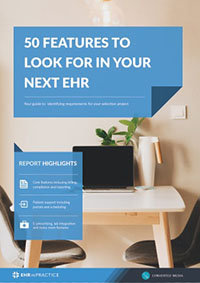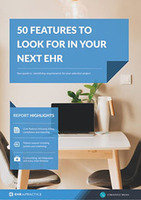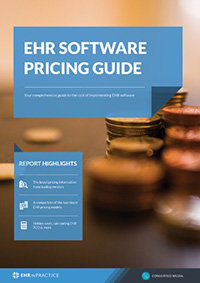The ultimate EHR features guide
One of the more common underlying causes of an unsuccessful EHR implementation involves finding an EHR product that can offer the features needed to enhance clinical and organizational performance. Further compounding problems, when an EHR’s features are not appropriate for a practice’s mission there can be a spillover of negativity into other areas including lower job satisfaction, disruption in workflows and overall negative feelings toward the EHR’s role in the practice. Not only from a financial perspective but from an overall clinical operational perspective, it is important to select the right EHR features.
Selecting the right EHR features for your practice needs
Selecting the right EHR features is essential in making certain that an investment in an EHR can provide a return on investment. EHR features can be best described as the tools needed to further strategic an organization’s strategic goals. For example, a practice looking to improve workflows among its clinical staff would not spend an inordinate amount of time fretting over EHR billing features, while not focusing on features that can streamline how clinic data is entered and managed in the system.
As such the “right” features are those that can provide the best opportunity to accomplish progress toward your practice’s goals. Those that are not fulfilling this purpose should not be totally ignored but should be deprioritized for the time being
Top 10 EHR features
When considering what EHR features your practice will want to make certain is offered in a product one can easily be overwhelmed by the options that are available in the EHR software product market today. With the wealth of options available in the current market, selection teams are often challenged by determining not only what features their organization requires, but whether an EHR feature is necessary to meet your organization’s goal.
As a preliminary matter, what one would consider “top features” in an EHR product will vary based on the type of healthcare organization. The needs of a specialty practice will differ from that of a general practice just as a hospital’s needed features will differ from independent ambulatory practice. Despite the differences in EHR requirements one can still identify EHR features that all organizations can, regardless of their size and area of medical practice, can find beneficial. These general features have been identified by the Institute of Medicine’s Key Capabilities of an Electronic Health Record System. The eight core functions identified by the IOM are:
- Health information and data capabilities: patients' diagnoses, allergies, lab test results, and medications.
- Result management: the ability for all providers participating in the care of a patient in different settings to quickly access new and past test results.
- Order management: the ability to enter and store orders for prescriptions, tests, and other services to enhance legibility, reduce duplication, and improve the speed with which orders are executed.
- Decision support: using reminders, prompts, and alerts, computerized decision-support systems would help improve compliance with best clinical practices, ensure regular screenings and other preventive practices.
- Electronic communication and connectivity: efficient, secure, and readily accessible communication among providers and patients to improve the continuity of care, increase the timeliness of diagnoses and treatments, and reduce the frequency of adverse events.
- Patient support: tools that give patients access to their health records, provide interactive patient education, and help them carry out home-monitoring and self-testing can improve control of chronic conditions
- Administrative processes and reporting: computerized administrative tools, such as scheduling systems, to improve hospitals' and clinics' efficiency and provide more timely services to patients.
- Reporting and population health: electronic data storage that employs uniform data standards will enable health care organizations to respond more quickly to reporting requirements, including those that support patient safety and disease surveillance.
When moving beyond the core IOM features, there are a number of features that can be considered important features every practice should consider as part of an advanced EHR strategy.
The following list of features was selected based on their role in enhancing performance in three areas: patient engagement, quality of care, and clinical and financial data analytics.
1. MACRA/MIPS performance tracking
Quality of care is not only an important clinical goal, but it also is important from the perspective of collecting revenue, specifically if a practice delivers services billable under Medicare Part B. Given the fact CMS has instituted value-based billing and incentives for providers based on their MACRA/MIPS scores. Therefore, being able to track MACRA/MIPS performance is important EHR feature that can play a role in avoiding penalties and possibly gaining QPP bonuses. With this type of feature, a practice can track its performance on MIPS scoring categories.
2. Revenue cycle management (RCM)
Data indicates that healthcare practices who use an EHR with an integrated RCM platform collect 29 percent more on billed charges when compared to nonintegrated practice management and RCM platforms. RCM allows an organization to track revenue performance by looking at a number of revenue centered metrics from a centralized dashboard to track real-time performance and make prospective decisions based on these data.
3. Customer Relations Management (CRM)
Customer relations is not often considered a core healthcare function it is an important consideration from a business standpoint and from ensuring the patient satisfaction scores under MACRA/MIPS. Customer relations management features are often features found in practice management software can offer practices the ability to monitor patient satisfaction metrics and conduct surveys to pinpoint problem areas or strong points.
4. Patient-provider communication
A study published in the journal BMJ Quality and Safety found that participants who reported high satisfaction and good provider communication were less likely to be readmitted. EHR features that can allow patients to communicate directly with their providers are often found in patient portal packages. However, simply offering this type of feature may not suffice rather, it is important to users can communicate with their providers in a secure environment and can use these tools easily.
5. EHR alerts
An EHR should offer not only risk-based alerts such as drug interactions but provide alerts regarding preventive care. Evidence shows that using (and adhering to) CDS-based EHR alerts can improve patient health outcomes, cost efficiency, and potentially enhance care management. An observational study of 26,424 patient encounters spanning three years published in the American Journal of Managed Care indicates that adherence to real-time CDS alerts was correlated with consistent improvements on the following variables: length of stay, the probability of readmission after 30-days, the probability of complications, and total direct costs of care.
6. Speech recognition
Reaction Data recently released a report focusing on speech-enabled EHRs, speech recognition technology allows a clinician to speak into an electronic device which then translates these spoken words into written text. Speech recognition tools offer the ability to reduce data entry times and allow clinicians to spend more time with patients rather than entering data. The report indicates that the clear majority of the provider is considering this technology. In the Reaction Data study, 62 percent of providers said they are currently using speech recognition in their EHRs. Eleven percent said they will adopt speech recognition within the next two years and 4 percent said they are currently implementing it.
7. Financial dashboards
In a competitive climate where practices often face tight operating margins the ability to track analyze practices, overall financial performance is vital. As such, practice management software contains features that allow all users, not just those in finance to analyze a practice’s financial performance through easy to use and understand dashboards that can generate reports on a number of clinical and financial metrics.
8. Advanced clinical decision support
Advanced clinical decision support systems offer a way for clinicians adhere to clinical best practices. Functionally clinical decision support systems offer providers patient-specific information to enhance health and health care.
Check out the top EHR features for practice management in our free EHR guide
9. Medication decision support
Like other clinical decision support features, medication decision support is a tool to reduce risk and enhance the quality of care by offering evidence-based information concerning a drug therapy’s effectiveness in treating a condition. When used in conjunction with an adverse drug interaction/event alerts it can add an extra layer of protection against preventable adverse drug events. According to the Center for the Advancement of Health, medication decision support has had a measurable impact on safety. U.S. hospitals have realized a 66 percent drop in prescription errors after switching to decision support systems.
10. Electronic patient information and education
Given the importance of patient taking an active role in their own health, care providers should be able to offer patients educational material and reminders on a number of topics. One such example that plays a large role in patient population health is the proper use of medications. These alerts and education material advise patients of potential side effects and ensure medication adherence. Further, these features can patient experience with on-demand patient education materials that can be used to increase preventative care and to reduce health risk behavior.
Free white paper

50 features to look for in your next EHR
A comprehensive guide to EHR features and how they can benefit your practice

Featured white papers
-

50 features to look for in your next EHR
A comprehensive guide to EHR features and how they can benefit your practice
Download -

EHR Vendor Directory
Get the most up-to-date directory of EHR software vendors. Find the best software for your practice.
Download -

EHR Pricing Guide
Get your complete guide to EHR software pricing and project costs. Your headstart on EHR pricing research
Download
Related articles
-

EHR requirements and key features: your complete guide
Our extended guide to EHR requirements - everything you need to know and more on the subject
-

What are the core functions of EHR
The basic functionality that your EHR should include
-

The most important EHR features for practice management
The key functionalities any practice management software should have

